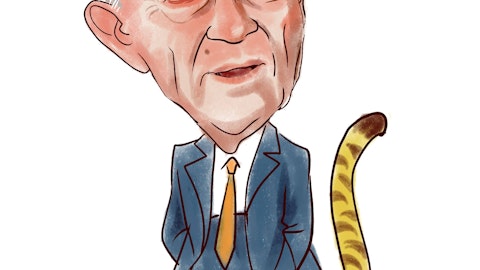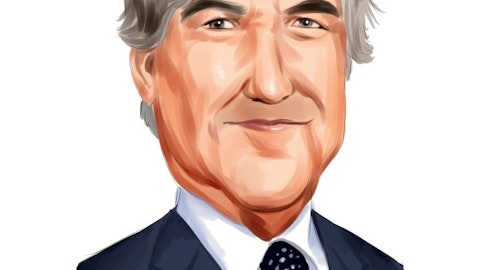SLM Corporation (NASDAQ:SLM) Q4 2022 Earnings Call Transcript February 2, 2023
Operator: Good day, and welcome to the 2022 Fourth Quarter Sallie Mae Earnings Call. At this time, all participants are in a listen-only mode. After the speakers’ presentation, there will be a question-and-answer session and instructions will be given at that time. As a reminder, this call is being recorded. I would now like to turn the call over to Melissa Bronaugh, Vice President, Investor Relations. You may begin.
Melissa Bronaugh: Thank you, Michelle. Good morning and welcome to Sallie Mae’s fourth quarter 2022 earnings call. It is my pleasure to be here today with Jon Whitter, our CEO; and Steve McGarry, our CFO. After the prepared remarks, we will open up the call for questions. Before we begin, keep in mind our discussion will contain predictions, expectations and forward-looking statements. Actual results in the future may be materially different from those discussed here. This could be due to a variety of factors. Listeners should refer to the discussion of those factors on the company’s Form 10-Q and other filings with the SEC. For Sallie Mae, these factors include, among others, the potential impacts of the COVID-19 pandemic on our business, results of operation, financial conditions and/or cash flows.
During this conference call, we will refer to non-GAAP measures, we call our core earnings. A description of core earnings, a full reconciliation to GAAP measures and our GAAP results can be found in the earnings supplement for the quarter ended December 31, 2022. This is posted along with the earnings press release on the Investors page at salliemae.com. Thank you. And now, I’ll turn the call over to Jon.
Jonathan Witter: Thank you, Melissa and Michelle. Good morning, everyone. Thank you for joining us today to discuss Sallie Mae’s fourth quarter and full year 2022 results and our outlook for 2023. I hope you’ll take away two key messages today. First, on most dimensions Sallie Mae had a strong 2022. Second, we now believe that the level of charge offs we experienced in 2022 will likely improve, but remain at an elevated level for a period of time. As such, we have taken tough financial and operational medicine to start to put that impact behind us. And third, and as a result, we believe we have strong momentum entering 2023 and are well positioned for future success. As we released last night, Sallie Mae experienced a loss of $0.33 a share in Q4 and diluted earnings of $1.76 a share for the year.
This quarterly loss was due to both an increase in our provision for credit losses, as well as the write-down of the value of an investment in non-marketable equity securities. As Steve and I will discuss, we believe both charges help position Sallie Mae for strong performance in 2023 and beyond. Absent these charges, our financial results for the quarter were in line with our guidance expectations. Let’s get into the details that drove our performance in the quarter and the year. Private education loan originations for the fourth quarter of 2022 were $819 million, which is up 11% over the fourth quarter of 2021. Consistent with guidance on our last call, our full year originations ended at approximately $6 billion, which is up 10% over 2021.
This momentum has carried into 2023 as we have just experienced the strongest January originations month in our company’s history. We also saw a notable market share growth in 2022. Sallie Mae’s share of the core student loan lending market increased 200 bps year-over-year according to the most recent industry report, reflective of our 2022 peak season success. We also observed important changes in the mix of our originations. Specifically, we saw a 15% increase in underclass disbursements compared to last year. Underclass originations have higher lifetime value to us due to greater serialization opportunity, which bodes well for future peak seasons. This performance was driven by a number of factors, including realized benefits from our acquisition of Nitro College, improvement in our marketing effectiveness enabled by past MarTech investments and the strength of our partnership and school relationships.
Credit quality of originations was consistent with past years. Our cosigner rate for fourth quarter 2022 was 82% versus 83% in the fourth quarter of 2021. Average FICO score for the fourth quarter of 2022 was 747 versus 749 in the fourth quarter of 2021. For the full year, our originations were 86% cosigned and had an average FICO score of 747. Year in and year out, our quality loan portfolio generates net interest income, significant net interest income. For the full year of 2022 we earned $1.5 billion of net interest income, higher than full year of 2021 despite having slightly lower loan balances. In this rising rate environment, our treasury team has effectively managed interest rate risk and grown our net interest margin from 4.81% in 2021 to 5.31% in 2022.
We have also managed expenses rigorously in this highly inflationary period coming in on the lower end of our guidance at $559 million. This is despite an increase in volumes and in costs such as wages, benefits and other expenses. Despite this pressure, we continue to ruthlessly prioritize and invest in our most important operational and strategic initiatives. In the fourth quarter of 2022, we continued our capital return strategy, repurchasing 10 million shares at an average price of $16.25. We have reduced the shares outstanding since January 1 of 2022 by 14% at an average price per share of $17.58. We have reduced the shares outstanding since January 1 of 2020 by 44% at an average price of $15.44. While we are excited about this performance, charge off results in the year were worse than our original expectations.
Specifically, as discussed on page 15 and 16 of our earnings press release, our net private education loan charge offs for the year were $386 million, above the revised range we set at the end of the second quarter. You will remember at that time we expected charge offs to remain elevated in Q3 and begin to abate in Q4. While we have seen improving performance in many of the transient factors we previously discussed, some factors remain elevated. In addition, while we don’t see evidence of stress across the portfolio as a whole, we began to see elevated levels of delinquency and charge offs in pockets of our portfolio toward the end of the year. As we assess industry and competitor data, we believe this is a trend similar to those seen in other areas of consumer lending.
These combined factors have led us to conclude that while we expect charge offs to be lower in 2023 than in 2022, the charge off rate will likely remain elevated. In fact, we saw this play out in January where results improved relative to our expectations. We have reflected this view in our charge off estimate in results and allowance calculations. Specifically, we expect charge offs in 2023 will be between $345 million and $385 million. As a result, we added $181 million to our reserves in Q4. In addition to this charge off outlook, this provision build incorporates portfolio and commitment growth, modeling changes and a true up of modeled and actual results. Roughly 70% of this allowance build is related to elevated charge off expectations over 2023 and into 2024 that I described a moment ago.

Photo by Rodeo Project Management Software on Unsplash
The remaining 30% comes from a prudent assumption that while we are optimistic that credit will eventually normalize, we are not willing to assume an immediate improvement where we and others are continuing to see economic stress. In addition to this financial charge, we have also made significant changes to our people, processes and programs to improve loss performance. We will continue to evaluate performance and the effectiveness of these changes and make further enhancements to our operations as results dictate. The other main factor of our financials in Q4 involve the valuation of our investment in non-marketable equity securities. In the third quarter, we made the decision to exit the credit card business and divest the portfolio. However, as you may recall, we made a strategic investment in a service partner when we entered the credit card business in 2018.
In 2021, we marked this investment up by $35 million. However, based on prevailing market sentiment in the fourth quarter of 2022, we were required to write the asset down and have done so by $60 million. The remaining investment on our balance sheet is immaterial. The increase in our provision and the write down of our equity investment were the primary drivers of EPS coming in approximately $0.74 lower than our expectations. About two-thirds of this impact was driven by the provision build I just described and the remainder was due to the write down of a strategic investment in a business line we are exiting. Steve will now take you through some additional financial highlights of the quarter. Steve?
Steve McGarry: Thank you, Jon. Good morning, everyone. Let’s continue with a deeper dive into our loan loss allowance and provision. Our total provision for credit losses on our income statement was $297 million in the quarter, driven by an allowance build of $181 million and net private education loan charge offs of $116 million. This Q4 provision represents an increase of $90 million from the prior quarter and $313 million from the year ago quarter. At a more detailed level, the increase in allowance during the fourth quarter brings our private education loan reserve to $1.48 billion or 6.3% of our total student loan exposure, which under CECL includes the on balance sheet portfolio, plus the accrued interest receivable of $1.2 billion and unfunded loan commitments of another $2 billion.
As Jon mentioned, there are a few factors that influence this increase in allowance, the largest being our charge off expectations over 2023 and into 2024 due to the persistence of operational issues, credit administration practice changes and the potential for increased pressure on our borrowers from the current economic environment. We also built allowance in the quarter for slower than expected prepayments. Let’s now discuss our credit metrics. Private education loans delinquent 30 plus days were 3.8% of loans and repayment, a slight uptick from 3.7% in Q3 and up from 3.3% in the year ago quarter. It is worth reminding everyone that a natural result of reducing forbearance is an uptick in delinquencies. In fact, since we implemented our forbearance policy changes, the increase in our 30 plus delinquency rate is equal to the decline in forbearance usage.
We now expect 30 plus day delinquencies to remain at recently experienced levels through 2023. Private education loans and forbearance were 1.8% at the end of the quarter, an increase from 1.4% at the end of Q3, and lower than 1.9% from the year ago quarter. As May graduates exit their grace period in November and December, it is typical to see seasonal pressures push up forbearance usage. Net charge offs for the portfolio were 3.1% in the fourth quarter compared to 2.7% in Q3 and 1.6% in the year ago quarter. Full year charge offs were 2.55% in 2022 compared to 1.33% in 2021. We expect the private education loan charge offs for the full year of 2023 to total 2.4% to 2.5%. As Jon mentioned earlier, we are appropriately reserved for this outlook.
Let me provide some further context around our projections and implications for lifetime loss. Today’s discussion has highlighted the fact that we continue to believe 2022 charge offs do not reflect our long term run rate. This belief is reflected in our provision, whereas Jon mentioned earlier, 70% of the increase was driven by expectations of elevated charge offs over the next two years. With that said, we also believe that our 2021 charge off rate of 1.33% does not reflect our long term expectations either. We believe that our long term through the cycle loss rate should be closer to 1.9% to be consistent with our expected life of loan default rates at underwriting. In recent years, we have seen loss rates well beneath that. 2022 was a catch up year for a lot of reasons that Jon and I have already discussed.
However, when we look at vintage curves and the expected remaining credit performance of our assets over time, we think that life of loan losses will be within the estimated range, anticipated at underwriting and will continue to drive attractive returns and profitability going forward, generating life of loan return on equities in the 20% range despite recent credit performance. Jon has already reported on our solid NIM performance. I would like to add to that discussion that we remain marginally asset sensitive and should benefit from a continuation of rising rates. We continue to expect our NIM to exceed 5% throughout 2023. Income tax expense for the year was $162 million. This represents an effective tax rate of 24.9%, which is a reasonable run rate for our company.
Fourth quarter operating expenses were $138 million compared to $150 million in the prior quarter and $125 million in the year ago quarter. Expenses were down from the prior quarter which was our peak lending season. Full year operating expenses in our core student loan business increased just 7.8% from the prior year despite significant inflationary pressures and dispersed volume being up 10.2%. We will continue to focus on driving both servicing and acquisition costs lower on a unit basis. Finally, our liquidity and capital positions remained strong. We ended the quarter with liquidity of 23.5% of total assets. At the end of the fourth quarter, total risk based capital was 14.2% and common equity Tier 1 capital was 12.9%. GAAP equity plus loan loss reserves over risk weighted assets are an important metric and the CECIL environment was in a very strong 15.9%.
We believe we are well positioned to continue to grow our business and return capital to shareholders going forward. I’ll now turn the call back to Jon.
Jonathan Witter: Thanks, Steve. As I said previously, I believe Sallie Mae is well positioned for the future. While we expect the private student lending market to return to a more normalized growth rate in 2023 compared to the post COVID bounce back year of 2022, our originations engine is strong and prepayment speeds continue to slow, both of which bode well for balance sheet growth or continued loan sales. Our NIM is resilient and we have demonstrated strong expense management. While charge offs are elevated, we have taken measures by increasing reserves and making operational changes that we expect should help insulate future performance from these effects. On top of these factors, we are also seeing positive signs in the fixed income markets.
Rates are now at the levels where we executed our 2022 loan sales. Credit spreads are normalizing and prepayment speeds slowing. All of this helps support future loan sale plans. As such, subject to market conditions, we plan to sell $3 billion of loans in 2023 in keeping with our past loan sale and share buyback arbitrage program. These sales are likely to take place in Q2 and Q3. In addition, under our 2022 share repurchase program, we still have the authority to purchase $581 million worth of shares this year. We do not anticipate having to seek additional board approval for repurchases this year. Beyond 2023, we remain committed to our capital return strategy. It is in this context, I’d like to provide our guidance for 2023. Specifically, we expect full year diluted non GAAP core earnings per share between $2.50 and $2.70.
Full year private education loan origination growth of 5% to 6%. We expect our non-interest expenses for the full year of 2023 to be between $610 million and $620 million. And as stated earlier, we expect our loan portfolio net charge offs will be between $345 million and $385 million. With that, Steve, let’s open the call up for questions.
See also 25 Most Viewed YouTube Videos of All Time and 11 Most Undervalued Natural Gas Stocks To Buy .
Q&A Session
Follow Slm Corp (NASDAQ:SLM)
Follow Slm Corp (NASDAQ:SLM)
Operator: Our first question comes from Moshe Orenbuch with Credit Suisse. Your line is open.
Moshe Orenbuch: Great. Thanks. Maybe just to think about, given the strength in originations in 2022, Jon, the deceleration that you’re seeing is — that you talked about or that you’re expecting, is it an element of conservatism or what do you think about — how do you think about that guide in the context of what’s happened now? We can see this morning a report that the freshman class at least has started to grow again. I know there has been some declines in college enrollment over the last couple of years. So can you put the 5% to 6% in context for us?
Jonathan Witter: Yes, sure. Happy to, Moshe, and good morning. Thanks for your question. I think the biggest thing to remember is, in 2021 we were still dealing with the impacts of the federal government HEERF program as a result of COVID. And that had, as you’ll remember, a pretty material impact on borrowing requirements for students as colleges had just a lot of money directly geared more toward direct aid in assistance to college. We are — we absolutely expected in our numbers last year to see a rebound of that program went away by statute. And I think we believe that the market this year will look more like a normal market. And I think our view is sort of long term this is a market that is growing in the sort of mid to upper single digits.
And that’s sort of the expectation that we have brought in. We have been, I think, excited by the performance we put out in 2022, both in terms of sort of the growth of the market and our market share gains. As I mentioned before, I think we saw a very strong, in fact a record setting start in our January originations. And so, I think we are optimistic about our originations outlook, but it’s really the loss of the HEERF program that led to a view of just a different market wise growth rate from 2022 to 2023.
Moshe Orenbuch: Okay. Got it. Thanks. And just as a follow-up, very good to hear your comments about the interest rate environment, we can see things with this spread environment is getting a little bit better. Can you talk a little bit about whether the improving margin slowing, kind of slowing prepays, but somewhat higher credit losses, how to think about that in the context of how we should be thinking about the value of those loans, the gain on sale that you can achieve?
Steve McGarry: Sure, Moshe. I’ll take a stab at answering that question. So the fixed income market has been extremely volatile and we saw our interest rates go up and come back down over 100 basis points from where we last executed. I think it’s pretty widely known that we last executed in the high single digits. And since that points in time, I think, (ph) spreads, which many of our loan buyers go to the ABS market to fund their purchases have actually tightened a little bit since then. The market is wide open and deals are getting done very actively. So that’s very, very encouraging. The fact that prepayments have slowed significantly, I think we saw consolidations down something like 50% year-over-year extends the life of these loans and generates additional residual cash flows, that is a very big positive.




